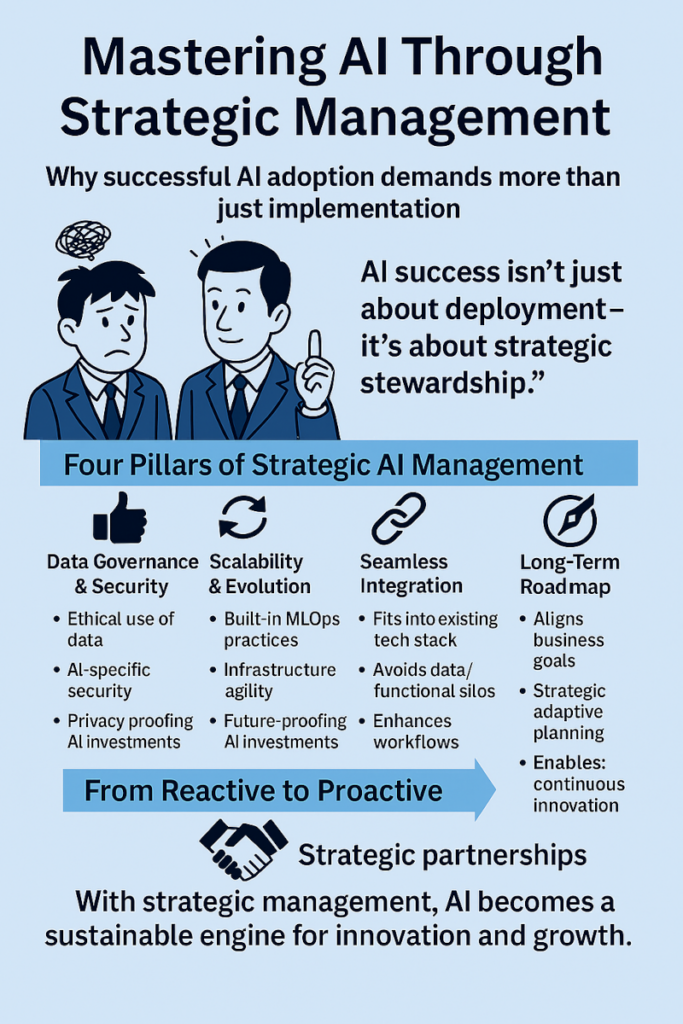
AI is everywhere—but too many businesses are diving in without a strategy, leading to security risks, siloed systems, and disappointing returns.
What if you could take the risk out of AI implementation and turn it into a scalable, secure, and truly integrated efficiency advantage for your business?
Discover the four pillars of strategic AI management that can future-proof your investments—or skip the read and book a quick one-on-one with Michael Weinberger to map it out for your company.

The artificial intelligence (AI) and automation tsunami is no longer approaching; it’s here. Businesses across industries are scrambling to harness its transformative potential, seeking efficiency gains, enhanced decision-making, and new avenues for innovation.
The allure of quick wins is strong, driving many organizations to focus intensely on the implementation of AI tools and platforms.
However, merely getting AI running is like launching a ship without a navigation system or a seasoned captain. To truly ride the wave of AI-driven transformation, rather than risk drowning in its complex undertow, businesses must shift their focus from tactical deployment to strategic, holistic technology management.
Simply implementing AI solutions without a robust management framework might yield short-term results, but it invites long-term risks and prevents organizations from unlocking the sustained competitive advantage AI promises.
True mastery lies in thoughtfully integrating these powerful technologies into the business fabric.
This requires a deliberate approach encompassing robust data governance and security, designing for scalability and evolution, ensuring seamless integration with the existing tech ecosystem, and developing a long-term, adaptive technology roadmap.
This article explores why strategic management is non-negotiable in the age of intelligent automation and outlines the key pillars technology leaders must prioritize to navigate this new era successfully.
AI and automation aren’t just another software upgrade; they represent a fundamental shift with unique characteristics and challenges:
Ignoring these unique facets and pursuing a purely tactical, project-by-project implementation approach invites significant risks:
As CIOs, CTOs, and IT Directors, the onus falls on us to champion this strategic shift. We must move beyond being mere implementers and become the architects and stewards of our organizations’ intelligent future, ensuring that AI adoption is not just technologically sound but also strategically aligned, governed, and sustainable.

Building a resilient and value-generating AI capability requires a foundation built on four strategic pillars:
1. Robust Data Governance & Security for AI:
Data is the lifeblood of AI. Therefore, robust governance and security are paramount. This extends beyond standard IT security protocols to address AI-specific challenges:
2. Designing for Scalability & Evolution:
Many AI initiatives stall after the pilot phase because they weren’t designed with growth in mind. True strategic management involves planning for scale from day one:
3. Seamless Integration with the Existing Tech Ecosystem:
AI tools deliver maximum value when they work harmoniously with existing core business systems (ERP, CRM, SCM, etc.), not in isolation. Strategic integration prevents data silos and ensures smooth workflows. It is important to think about how your integration strategy must change to accommodate AI:
4. Building a Long-Term, Adaptive Technology Roadmap:
Moving beyond ad-hoc AI projects requires a strategic roadmap that aligns technology initiatives with overarching business goals:
Embracing these pillars of strategic management embodies the very essence of being Proactive. Instead of reacting to security breaches after they occur, a proactive approach builds robust AI governance from the outset. Instead of scrambling when a successful pilot can’t scale, proactive planning ensures the necessary infrastructure and design are in place. Instead of dealing with fragmented data from siloed AI tools, proactive integration strategies ensure cohesion.
Strategic AI management is about foresight – anticipating challenges, planning for future needs, and steering the organization’s technological evolution deliberately.
Strategic AI planning transforms the IT function from a reactive support center or a simple implementer into a vital strategic partner, enabling the business to navigate the complexities of the AI era with confidence and purpose.
Developing and maintaining this level of strategic oversight requires a confluence of expertise – data science, cybersecurity, cloud architecture, data engineering, integration development, business strategy, and change management. Building this comprehensive capability entirely in-house can be daunting, particularly given the pace of change and the specialized skills required.
This is where a strategic technology partner becomes invaluable. Proactive Technology Management’s Fusion Development team, for instance, is built on the principle of integrating diverse technological capabilities – AI and machine learning, hyperautomation, data engineering, low-code/no-code development, and custom application building.
This “Fusion” approach mirrors the interconnected nature of strategic AI management itself. Partnering with a team that possesses this breadth and depth of expertise allows organizations to access the strategic guidance and technical execution needed to navigate the complexities of AI adoption successfully.
A true partner doesn’t just implement tools; they help architect the future, ensuring technology investments deliver lasting strategic value.
The age of AI and automation offers unprecedented opportunities, but realizing them requires more than just technological enthusiasm. It demands strategic discipline. Moving beyond tactical implementation to embrace comprehensive technology management – grounded in robust governance and security, designed for scalability, seamlessly integrated, and guided by a long-term roadmap – is no longer optional; it’s essential for survival and success.
By adopting a proactive, strategic approach to managing AI and automation, technology leaders can transform these powerful tools from potentially disruptive forces into controllable, predictable, and immensely valuable assets. This strategic mastery is the key to unlocking sustained innovation, driving competitive advantage, and confidently steering your organization into its intelligent future.